One of the most amazing things about woodpeckers is that practically everywhere you go, people can identify their sound. There are over 180 species of these wood-boring birds found almost everywhere. Up to 22 species of woodpeckers can be found in North America, and 14 of those species can be found in Texas. In actuality, the Lone Star State boasts 16 officially recognized species of woodpeckers.
Most are common in backyards and nearby parks, while one is rarely seen and another is extinct. The climate in Texas is variable and varies by region. The Eastern Texas Pineywoods are among the most frequented locations in Texas to look for woodpeckers. Below, we enumerate the 14 existing types of woodpeckers in Texas and how to identify them.
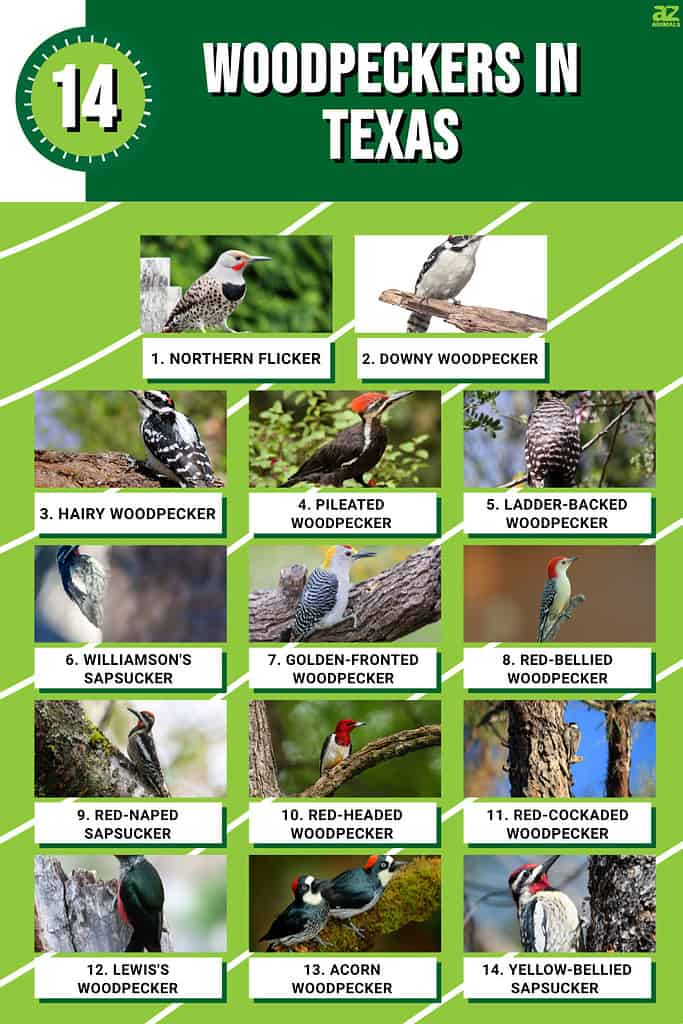
14 Types of Woodpeckers in Texas
1. Northern Flicker
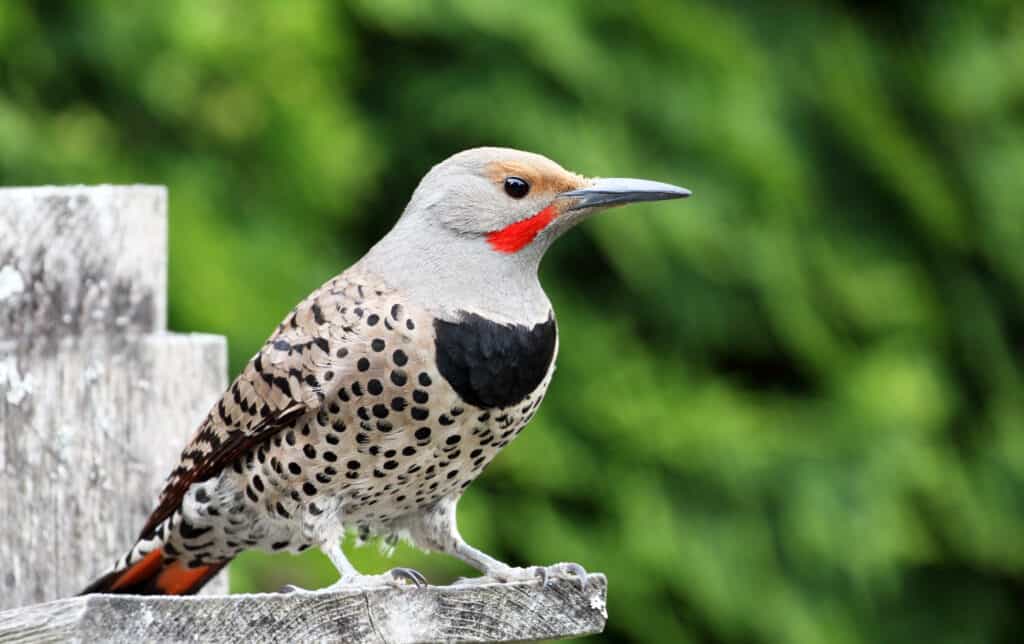
Northern flickers grow around 11 to 14 inches in body length
©Birdiegal/Shutterstock.com
Most of North America and the United States are home to some northern flickers. They have a winter range in Texas but live there all year in the northern and eastern parts. The red-shafted and yellow-shafted northern flicker are the two types that spend the entire year in Texas. Although the variants of this species vary, they all have the same basic characteristics, including an overall brown hue, a white rump, and black patches all over their bodies. Apart from having a wingspan of 17 to 21 inches, northern flickers grow around 11 to 14 inches in body length. Although their body weight can vary greatly, it typically ranges from 3 to 5.9 ounces. After the pileated woodpecker, flickers are the largest woodpeckers in Texas.
2. Downy Woodpecker
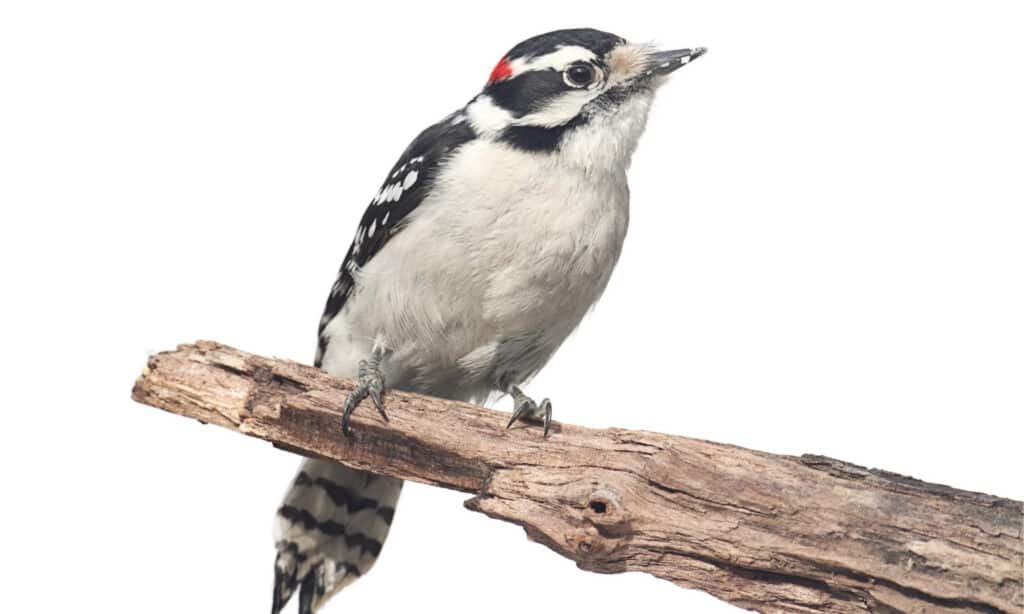
The downy woodpecker generally doesn’t migrate.
©Steve Byland/Shutterstock.com
The smallest woodpecker in North America is the downy woodpecker. These little woodpeckers are year-round eastern and northern Texas residents because they do not migrate. Only the northern and northeastern regions of Texas may view them, though there have been reports of sightings as far south as the eastern coast. Apart from having a wingspan of 9.8 to 12.2 inches, these birds have a body length of 5.5 to 7.1 inches. Though some weigh as much as 1.16 ounces, they normally weigh slightly under one ounce. This bird is primarily black, however, it has white on its head, wings, and bottom. Juveniles have a red cap, while males have a red patch on the back of their heads.
3. Hairy Woodpecker
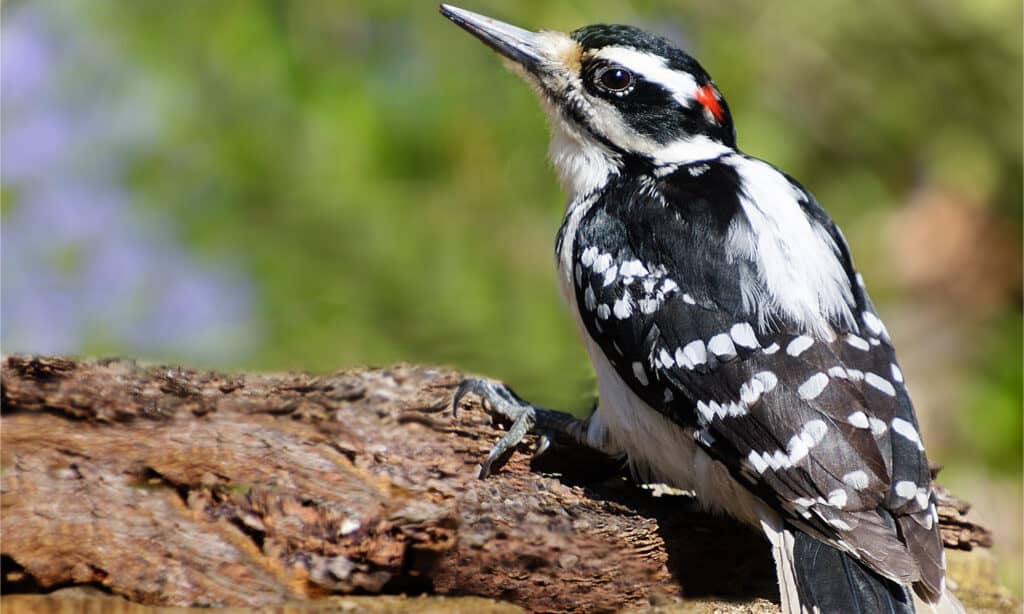
Like downy woodpeckers, hairy woodpeckers inhabit all of northern and eastern Texas.
©K Quinn Ferris/Shutterstock.com
You might be wondering if the image depicts a different downy woodpecker. No, although they do resemble one another. The similarities between the two, such as their small stature and pointed thin beaks, make it difficult for a beginner birdwatcher to distinguish between them. These medium-sized woodpeckers have pale bellies, dark wings, and dark backs. On top of their head, they have a feathered patch of orangey red. Like downy woodpeckers, hairy woodpeckers inhabit all of northern and eastern Texas and build their nests in forested areas with medium-sized or bigger trees. In comparison to downy woodpeckers, hairy woodpeckers have bigger bills.
4. Pileated Woodpecker
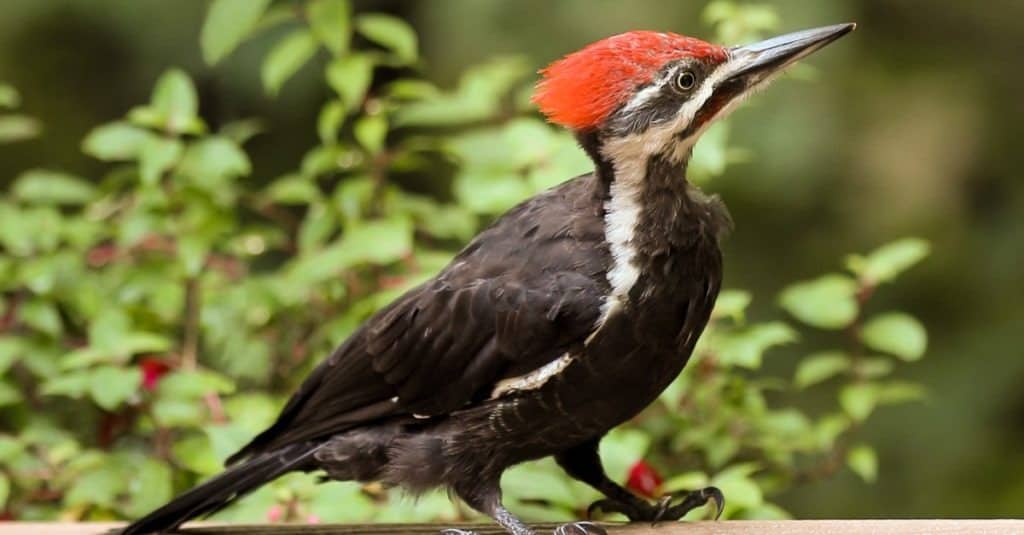
The pileated woodpecker has a body that is predominantly charcoal gray and is about the size of a crow.
©James.Pintar/Shutterstock.com
In Texas and North America, the pileated woodpecker is the biggest woodpecker species. The only larger woodpecker in North America is the ivory-billed woodpecker. The pileated woodpecker has a body that is predominantly charcoal gray and is about the size of a crow. It grows to a length of 16 to 19 inches on average and weighs 8.8 to 12.3 ounces. Its head and neck have distinct zebra stripes, and a brilliant red crest is perched on it. The bird uses its long, chisel-shaped bill to pierce branches and perform its trademark “drumming.” The eastern border of Texas is crossed by pileated woodpeckers, which can be seen yearly.
5. Ladder-Backed Woodpecker

The ladder-backed woodpecker has a checkered pattern on its wings.
©Peterwchen, CC BY-SA 4.0 – License
The barred, ladder-like pattern on the ladder-backed woodpecker’s back is undoubtedly already obvious to you, but did you know that it also has a checkered pattern on its wings? Except in the far east of Texas, where they are less frequent, they can be found year-round throughout most of Texas. Watch for ladder-backed woodpeckers from late January to March when they are nesting and more active. They have a 13-inch wingspan and weigh between 0.7 and 1.7 ounces. The conventional woodlands with big trees like oaks and pecans and arid, shrubby environments with lots of mesquites can support ladder-backed woodpeckers.
6. Williamson’s Sapsucker
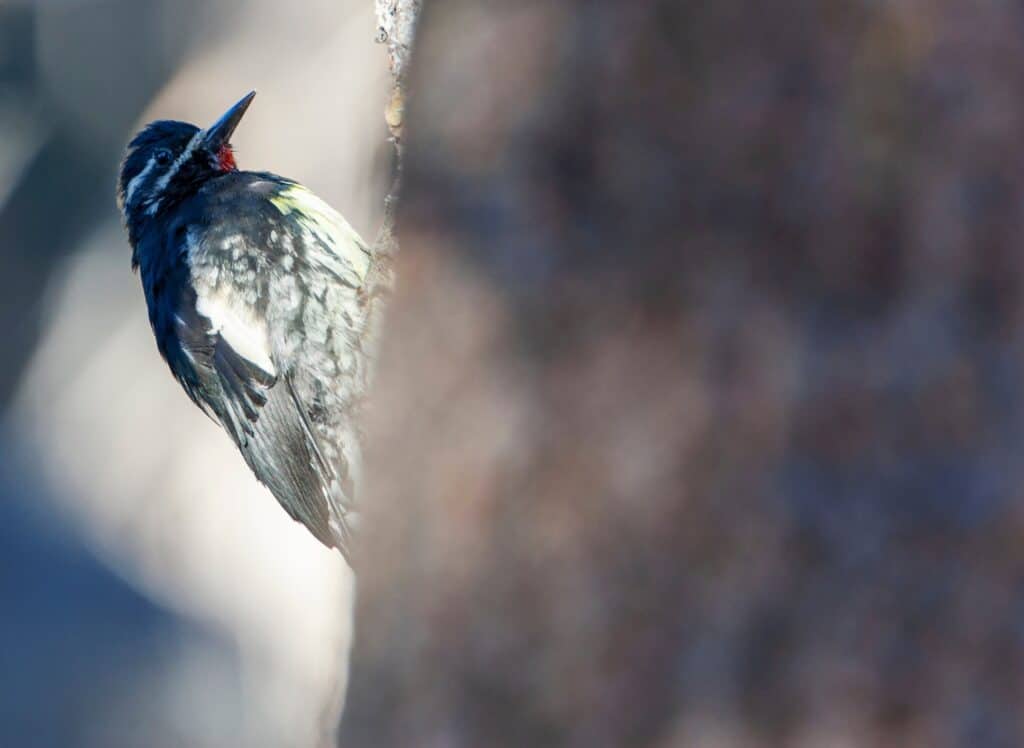
The Williamson’s sapsucker is primarily coated in black and white feathers.
©Traveller MG/Shutterstock.com
In the winter, the west Texas mountains, particularly the Guadalupe Mountains, are home to this species. A woodpecker of modest size, Williamson’s sapsucker is primarily coated in black and white feathers, and the bellies of the males are covered in bright yellow feathers. It is unfortunately uncommon to witness one or two of these species of woodpecker in the United States because they are only found in Texas outside of their mating season and have a small population. The most typical habitat for these woodpeckers is forests, particularly coniferous woodlands. In addition to eating ants and other insects during breeding, their main food source is the sticky sap they extract.
7. Golden-Fronted Woodpecker
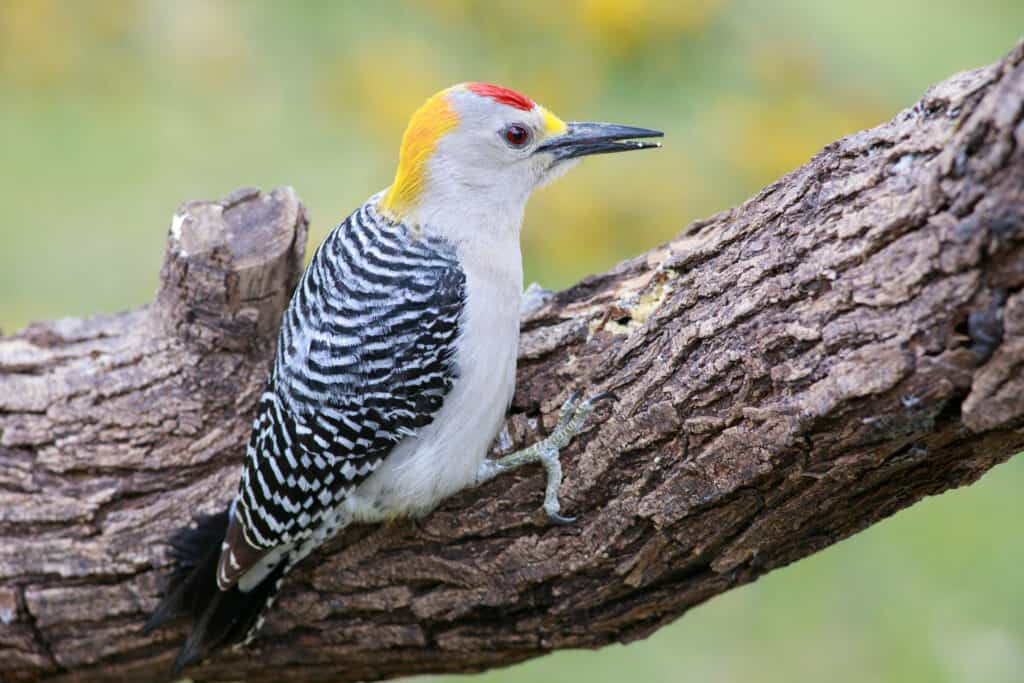
Golden-fronted woodpeckers can be spotted in southern Oklahoma and central Texas’ open woodlands and bushlands.
©Raul Baena/Shutterstock.com
This woodpecker has four distinct subspecies, which can be distinguished from one another by the golden feather patterns on their bellies, throats, and heads. The thin golden-fronted woodpecker may be easily identified in the woods because of its distinct golden-yellow patterns on the back of its head. Most of the golden-fronted woodpecker’s native range, where it can be seen all year long, is in Mexico and Central America. Nevertheless, they can be spotted in southern Oklahoma and central Texas’ open woodlands and bushlands. Large mesquites, pecan trees, and even oaks are favorites of these woodpeckers. For most Texas woodpeckers, suet is the best approach to entice them to your yard.
8. Red-Bellied Woodpecker
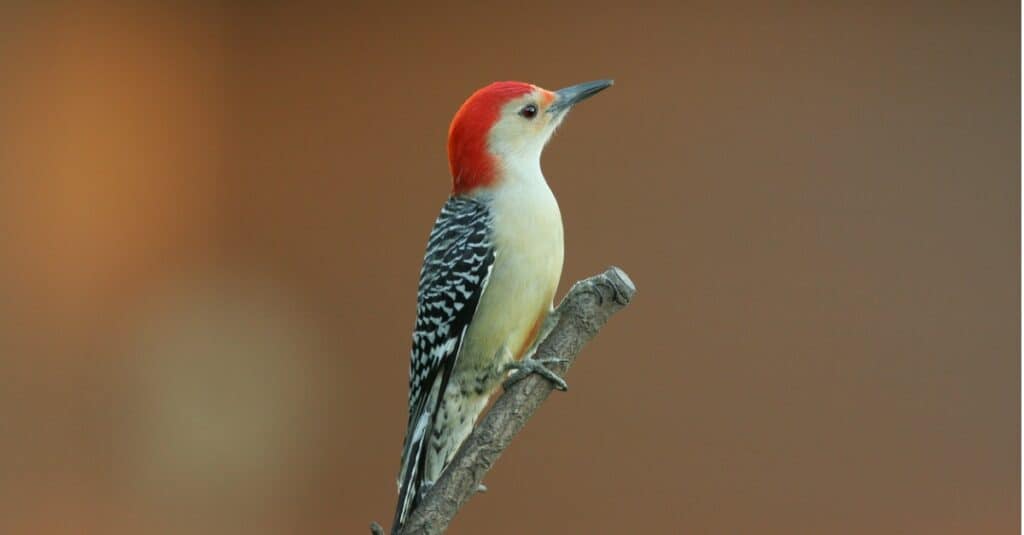
As confusing as the red head may be, the red-bellied woodpecker does, in fact, have a red belly.
©iStock.com/Flatcoater
The red-bellied woodpecker spends the entire year in east Texas and much of the country’s east. Look for the bright red on the tops of heads and backs of necks to recognize them. These woodpeckers’ crimson heads’ feathers are much more vibrant than their red bellies. Additionally, they have white and black feather stripes on their backs. They enjoy dense forests with big hardwood trees, especially those near brooks and river drainage. But if significant trees are nearby, you can also find them in surrounding neighborhoods and parks.
9. Red-Naped Sapsucker
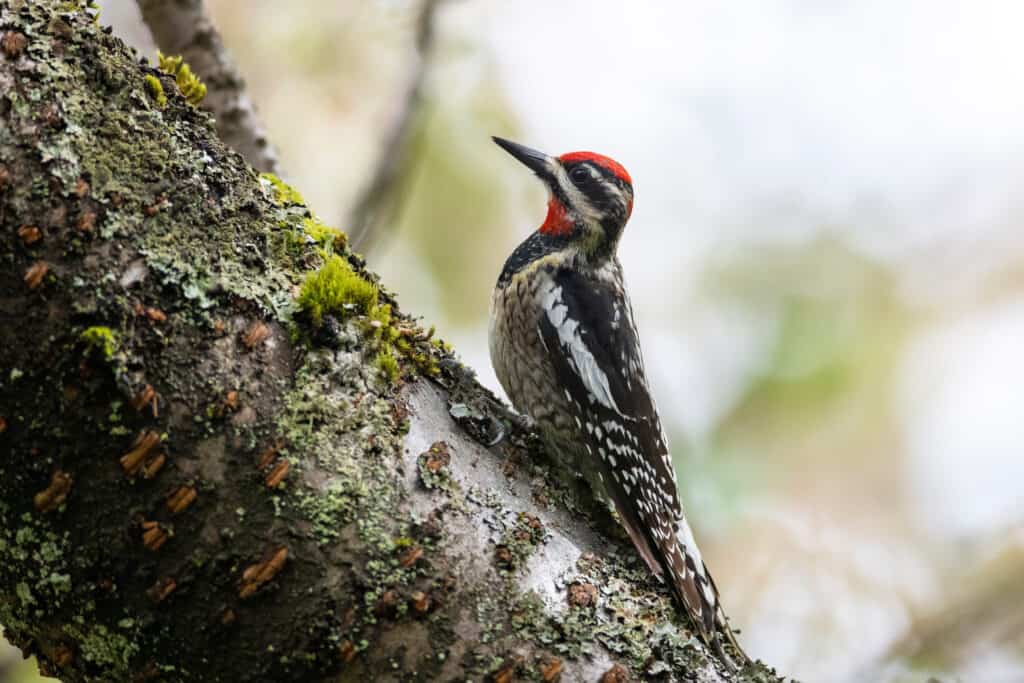
Red-naped sapsuckers occasionally inhabit huge trees like oaks, pecans, and sycamores.
©Feng Yu/Shutterstock.com
Eastern Texas regions, including Big Bend Country, the Davis Mountains, and the Guadalupe Mountains, are home to the red-naped sapsucker. These medium-sized woodpeckers have brilliant red throats, napes, and caps, and small white feathered patches are scattered across the rest of their black feathered body. Red-naped sapsuckers occasionally inhabit huge trees like oaks, pecans, and sycamores outside high-elevation mountain forest habitats, particularly near rivers and creeks.
10. Red-Headed Woodpecker
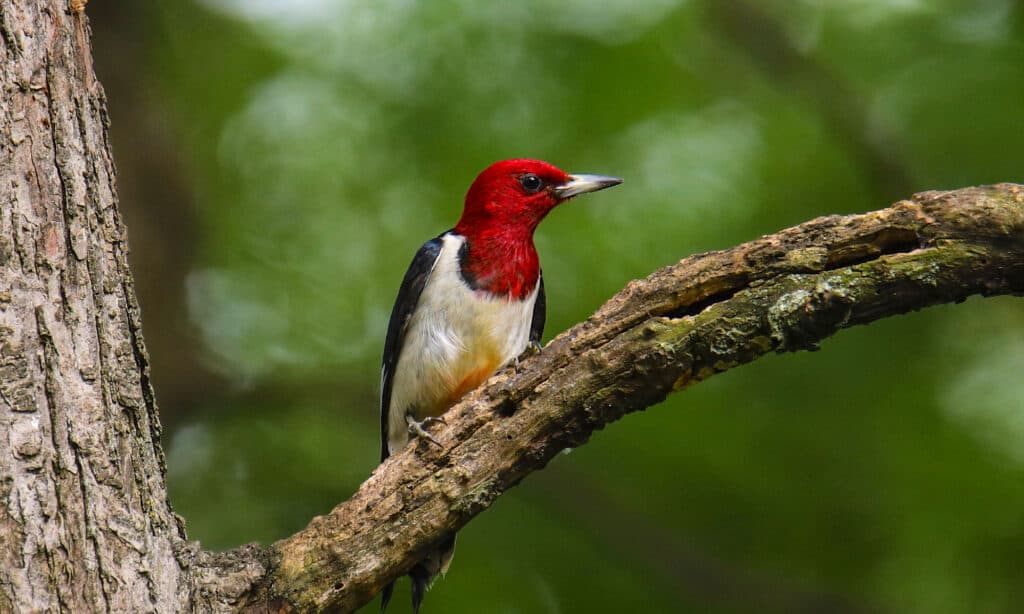
Red-headed woodpeckers occasionally inhabit the eastern panhandle.
©vagabond54/Shutterstock.com
The red-headed woodpecker, which is mostly found in central and eastern Texas, can be recognized by its entirely red or scarlet head. Its body is black with white markings on its wings and belly. This medium-sized bird is always on the go in search of food. Numerous species, including raccoons and Peregrine falcons, feast on them. For these rare woodpeckers to thrive, large hardwoods are necessary. They occasionally inhabit the eastern panhandle and can be found to the north and east of Houston and the north and east of Dallas.
11. Red-Cockaded Woodpecker
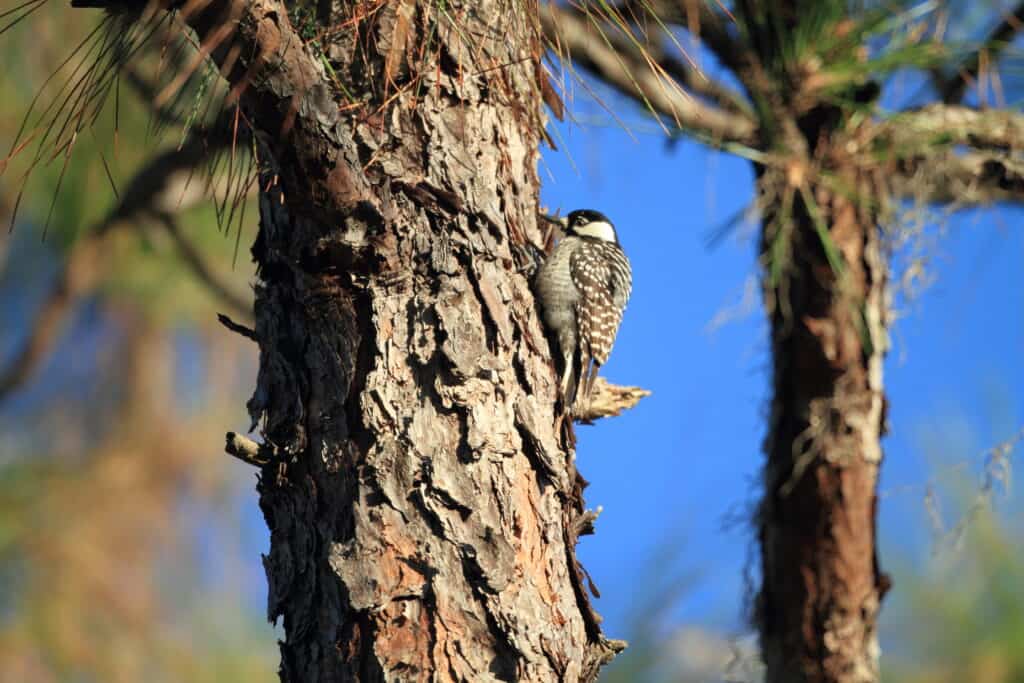
The red-cockaded woodpecker can be found in protected regions, such as state and national forests.
©feathercollector/Shutterstock.com
Texas is one of the few states in the United States where red-cockaded woodpeckers may be found, and their range is quite constrained. This endangered species can only be found in protected regions, such as state and national forests, where it dwells in mature Longleaf Pine savannas, a very particular habitat. Despite their name, these birds have pure white cheeks almost entirely covered in black and white feathers. Since they are rarely seen in the wild these days, a wildlife refuge offers the best chance of seeing one.
12. Lewis’s Woodpecker
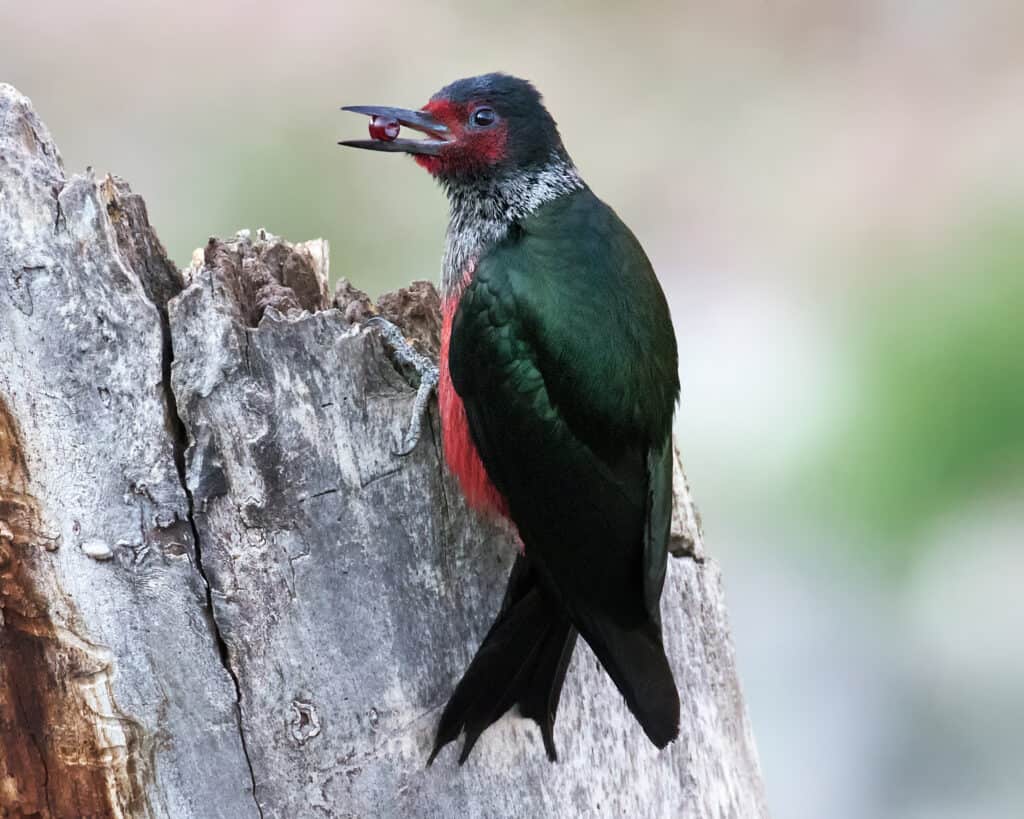
Lewis’s woodpeckers are most prevalent outside the breeding seasons.
©rbrown10/Shutterstock.com
Lewis’s woodpecker, one of the rare species, has pinkish-purple stomach feathers. However, that is not its only distinctive physical feature; it also has a tuft of greenish feathers on its head. The huge mountain ranges of the western United States are home to this distinctively colored woodpecker, which occasionally makes its way to Texas. Only the north and northwest regions of Texas have seen them, and they are most prevalent outside the breeding seasons. Lewis’s woodpeckers will occasionally appear in the state during the winter, but other times they won’t.
13. Acorn Woodpecker
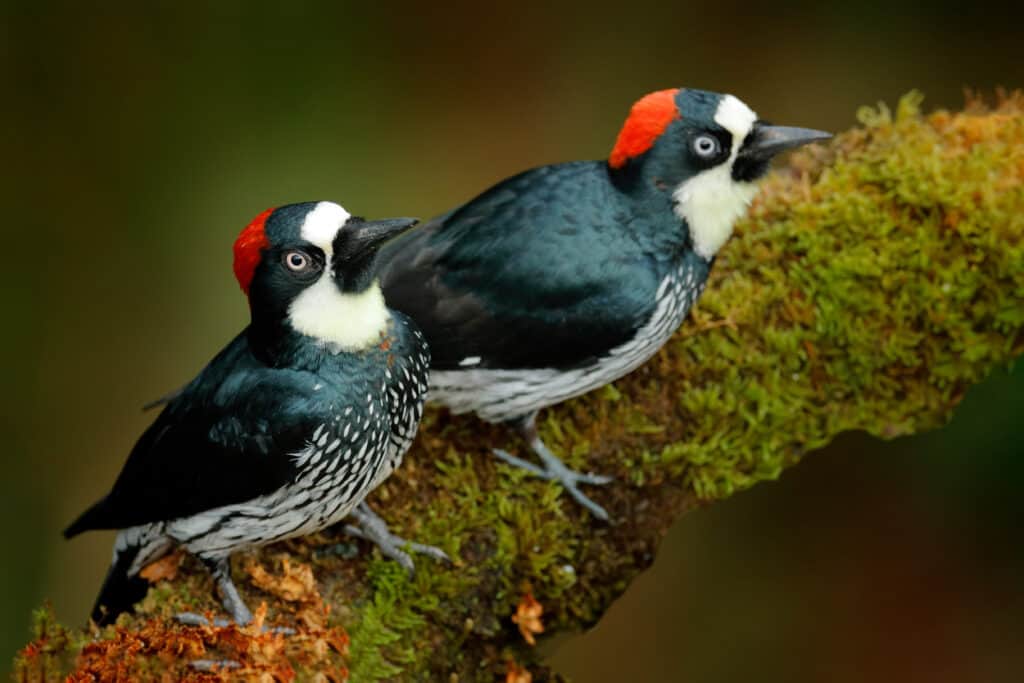
The only place acorn woodpeckers may be found in North America is east Texas.
©Ondrej Prosicky/Shutterstock.com
The medium-sized, rather chubby acorn woodpecker has a dark body with white patches on its belly and throat. One of its most distinguishing characteristics is its huge, “clown-like” eyes. The only place acorn woodpeckers may be found in North America is east Texas. They live in oak or pine-oak woodlands, where they consume acorns and insects. They were bestowed the name because they often stuffed hundreds of acorns into holes in trees constructed just for them.
14. Yellow-Bellied Sapsucker

Yellow-bellied sapsucker get their name from the pale yellow feathers on their bellies.
©iStock.com/impr2003
The majority of Texas and the eastern part of the country are home to the yellow-bellied sapsucker. Typically, one may observe them clinging to the huge, central trunks of tall trees. These woodpeckers get their name from their distinctive black and white feather patterns, red crowns, and pale yellow feathers on their bellies. Wintertime or late March and early April, when they travel north, would be good times to observe one. They move north to their breeding habitats in northern states and Canada from their non-breeding area in Texas.
Summary of 14 Woodpeckers in Texas
| Number | Woodpecker | Characteristics |
|---|---|---|
| 1 | Northern Flicker | Overall brown hue, a white rump, and black patches all over their bodies |
| 2 | Downy Woodpecker | Primarily black with white on its head, wings, and bottom. |
| 3 | Hairy Woodpecker | Pale bellies, dark wings, and dark backs; have a feathered patch of orangey-red on their heads. |
| 4 | Pileated Woodpecker | Head and neck have distinct zebra stripes, and a brilliant red crest is perched on it. |
| 5 | Ladder-Backed Woodpecker | Ladder-like pattern on back and wings |
| 6 | Williamson’s Sapsucker | Primarily coated in black and white feathers; males have bright yellow feathers |
| 7 | Golden-Fronted Woodpecker | Easily identified because of its distinct golden-yellow patterns on the back of its head |
| 8 | Red-Bellied Woodpecker | Crimson head feathers; have white and black feather stripes on their backs |
| 9 | Red-Naped Sapsucker | Brilliant red throats, napes, and caps; small white feathered patches scattered across the rest of their black feathered body. |
| 10 | Red-Headed Woodpecker | Entirely red or scarlet head; black body with white markings on its wings and belly |
| 11 | Red-Cockaded Woodpecker | Pure white cheeks almost entirely covered in black and white feathers |
| 12 | Lewis’s Woodpecker | Pinkish-purple stomach feathers; also has a tuft of greenish feathers on its head |
| 13 | Acorn Woodpecker | Dark body with white patches on its belly and throat; clown-like eyes |
| 14 | Yellow-Bellied Sapsucker | Distinctive black and white feather patterns, red crowns, and pale yellow feathers on their bellies |
The photo featured at the top of this post is © vagabond54/Shutterstock.com
Sources
- Wild Bird World, Available here: https://wildbirdworld.com/woodpeckers-in-texas/
- Birding Locations, Available here: https://birdinglocations.com/texas-woodpeckers/
- Bird Feeder Hub, Available here: https://birdfeederhub.com/woodpeckers-in-texas/
Thank you for reading! Have some feedback for us? Contact the AZ Animals editorial team.






